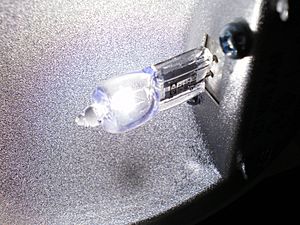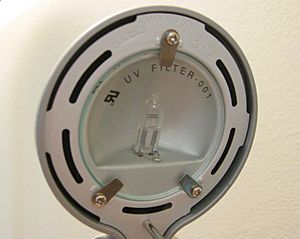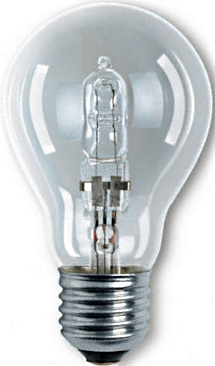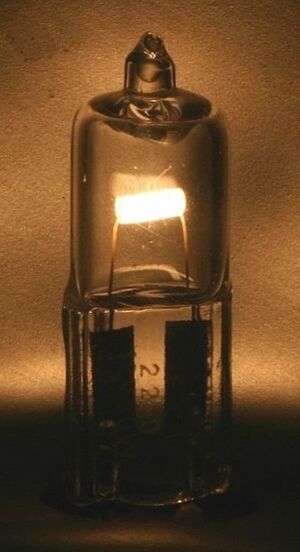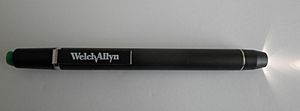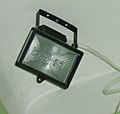Halogen lamp facts for kids
A halogen lamp is a special type of light bulb. It's also known as a tungsten halogen or quartz-halogen lamp. These lamps have a thin wire, called a tungsten filament, inside a small glass tube. This tube is filled with an inert gas and a tiny bit of a halogen chemical, like iodine or bromine.
The cool thing about halogen lamps is a special chemical process called the halogen cycle. This cycle helps put evaporated tungsten back onto the filament. This makes the bulb last longer and keeps the glass clear. Because of this cycle, halogen lamps can get much hotter than regular light bulbs. This means they produce brighter light and are more energy efficient. Their small size also makes them great for projectors and other focused lighting.
Contents
How Halogen Lamps Were Invented
People have been trying to make better light bulbs for a long time! In 1882, someone patented a carbon filament lamp that used chlorine to stop the glass from getting dark. Later, in 1892, "NoVak" lamps filled with chlorine were sold.
The idea of using iodine in a light bulb, and how it could put tungsten back on the filament, was suggested in a patent in 1933. But it wasn't until 1959 that General Electric (GE) created a practical halogen lamp using iodine.
In Europe, there have been efforts to stop using less efficient light bulbs. In 2016, certain types of halogen bulbs were banned. Other types were phased out in 2018.
How the Halogen Cycle Works
In a normal light bulb, the tungsten wire slowly evaporates. This evaporated tungsten sticks to the inside of the glass, making the bulb look black. Eventually, the wire gets too thin and breaks.
But in a halogen lamp, the halogen gas changes this! It creates a special chemical cycle. Here's how it works:
- When tungsten evaporates, the halogen gas reacts with it. They form a new chemical compound.
- This compound moves around inside the bulb.
- When it reaches the very hot parts of the bulb (like the filament), the compound breaks apart.
- The tungsten goes back onto the filament, and the halogen gas is set free to repeat the process!
This cycle keeps the bulb clean and bright throughout its life. For this cycle to work, the glass part of the bulb needs to get very hot, usually above 250°C (482°F). This is why halogen bulbs are often made of strong quartz or special high-temperature glass.
Because quartz is so strong, the gas inside the bulb can be at a higher pressure. This also helps the filament last longer and glow brighter. The tungsten usually goes back to slightly cooler parts of the filament, so the hottest spots still thin out over time and eventually cause the bulb to fail.
The first halogen lamps used iodine. Later, bromine was found to work even better. Sometimes, the halogen is mixed with a noble gas like krypton or xenon.
Halogen lamps that run on low voltage (like 12 to 24 volts) are very bright for their size. Their tiny filaments are great for controlling where the light goes. You might see these in "MR" lamps, which are often used for display lighting or in homes.
What Kind of Light Do Halogen Lamps Produce?
Like all incandescent light bulbs, halogen lamps produce a full range of light colors, from almost invisible ultraviolet (UV) to infrared (heat). Since the filament in a halogen lamp gets hotter, the light it produces is a bit "bluer" and brighter. This makes the light look more like natural sunlight.
Very hot filaments can also give off some UV light. To protect your eyes, many halogen lamps have special glass that blocks harmful UV rays. Sometimes, the halogen bulb is placed inside another outer glass bulb, which also helps block UV and makes the lamp safer to touch.
Safety Tips for Halogen Lamps
Halogen lamps get much hotter than regular light bulbs. This is because the heat is focused on a smaller glass surface, and the glass is very close to the super-hot filament. This high temperature is needed for them to work properly.
Because they get so hot, halogen lamps can be a fire risk and can cause serious burns. In some places, like Australia, many house fires have been linked to halogen lights in ceilings. Fire departments often suggest using compact fluorescent lamps or LED lamps instead, as they produce less heat. Some safety rules now require halogen bulbs to have a protective cover, especially for powerful ones used in theatre.
To reduce UV exposure and to keep hot glass pieces from flying out if the bulb breaks, many general-purpose halogen lamps have a special glass filter.
It's very important not to touch the glass part of a halogen bulb with your bare hands. The oil from your skin can create a "hot spot" on the glass when the lamp heats up. This extreme heat can damage the quartz glass, making it weaker and causing it to leak gas or even explode. Always use a clean cloth or gloves when handling a halogen bulb.
Different Shapes and Sizes of Halogen Lamps
Halogen lamps come in many shapes and sizes. They have special codes to describe them:
- T means "tubular." The number after it tells you the diameter in eighths of an inch. So, a T3 bulb is 3/8ths of an inch wide.
- MR means "metal reflector." The number after it also tells you the diameter in eighths of an inch.
- G means the lamp has two pins (bipin). The number after G tells you the distance between the pins in millimeters. For example, G6.35 means the pins are 6.35 mm apart. If there's a "Y" after the G (like GY6.35), it means the pins are thicker.
- C tells you how many coils are in the filament.
For long, tube-shaped bulbs, the length is also important and is usually given in millimeters. For example, "T3 120 V 150 W 118 mm" means a tube-shaped bulb, 3/8ths of an inch wide, that uses 120 volts and 150 watts, and is 118 millimeters long.
A common type is the R7S, which is a double-ended linear halogen lamp. These are usually 118mm or 78mm long.
Where Are Halogen Lamps Used?
Halogen lamps are used in many places:
- Cars: Many cars use halogen headlamps.
- Outdoor Lighting: They are often used for floodlights to light up outdoor areas or for boats.
- Homes and Offices: You might find them in desk lamps or in special indoor and outdoor floodlights.
- Stage Lighting: They are very common in theatres and TV studios for lighting up stages and sets.
- Projectors: Their small size and bright light make them good for movie or slide projectors.
- Special Uses: They can be used in scientific tools, medical instruments, and even in halogen ovens for cooking!
Interestingly, halogen lamps were used on the famous Times Square Ball in New York City until 2006. After that, they were replaced with LEDs because LEDs last much longer.
How to Dispose of Halogen Lamps
Halogen lamps do not contain any mercury, which is a harmful chemical found in some other types of bulbs. Most manufacturers say that the materials in halogen lamps do not make them hazardous waste.
Images for kids
See also
 In Spanish: Lámpara halógena para niños
In Spanish: Lámpara halógena para niños


